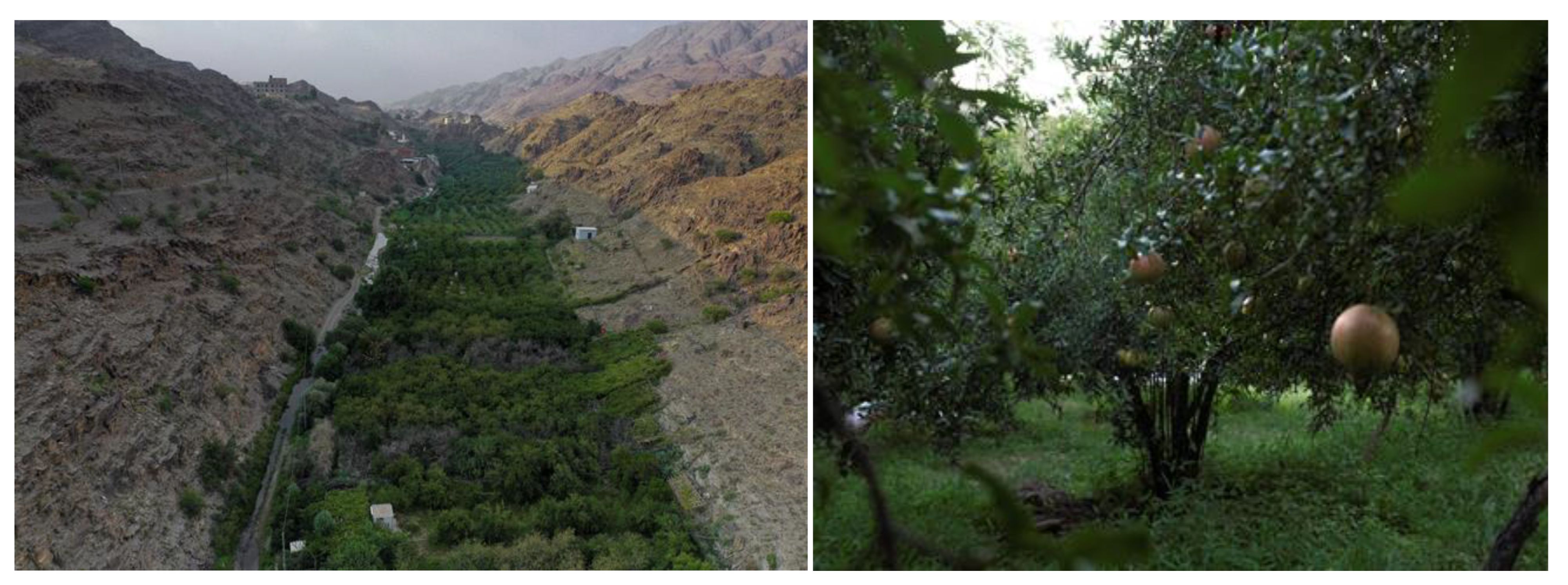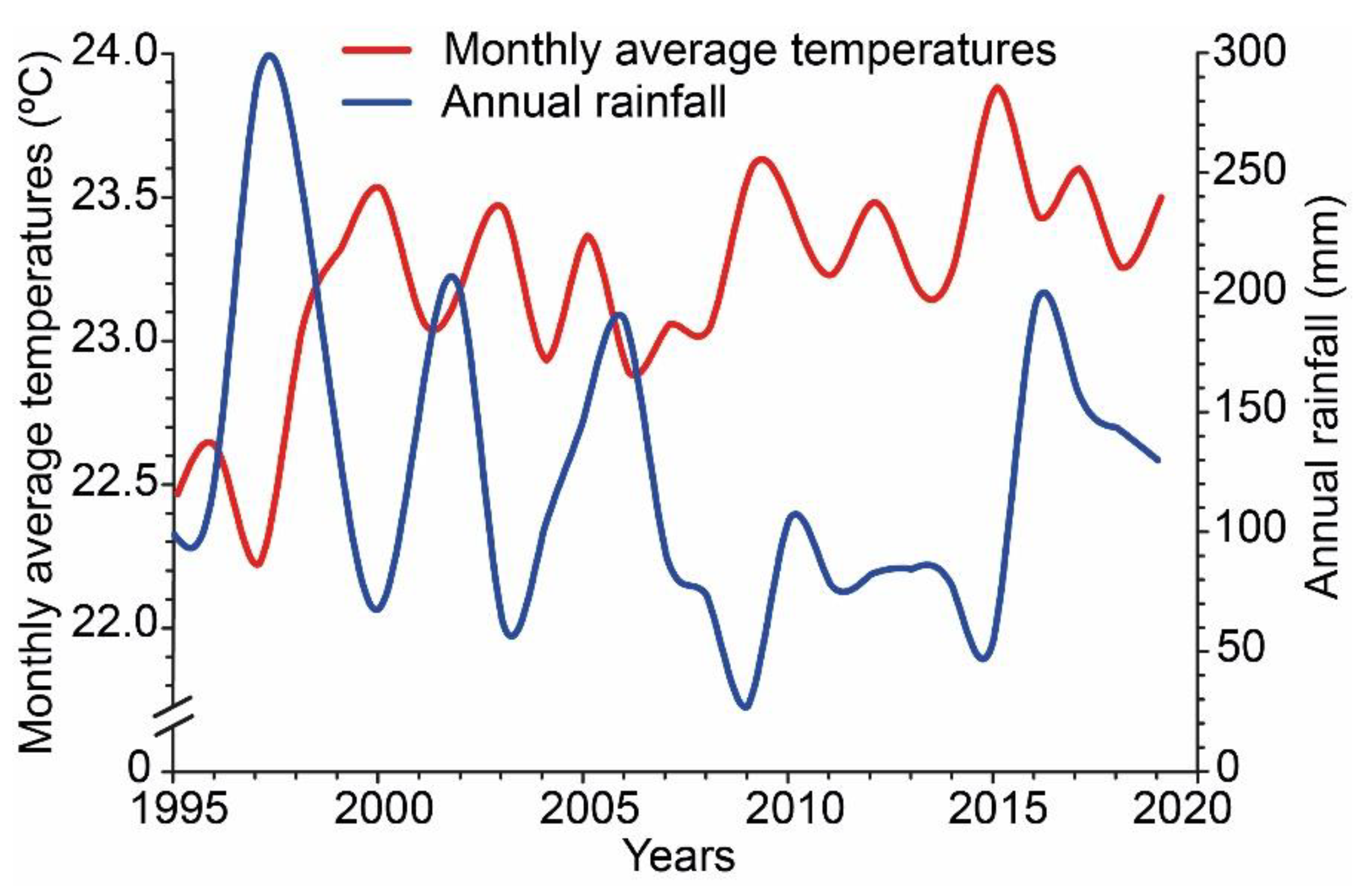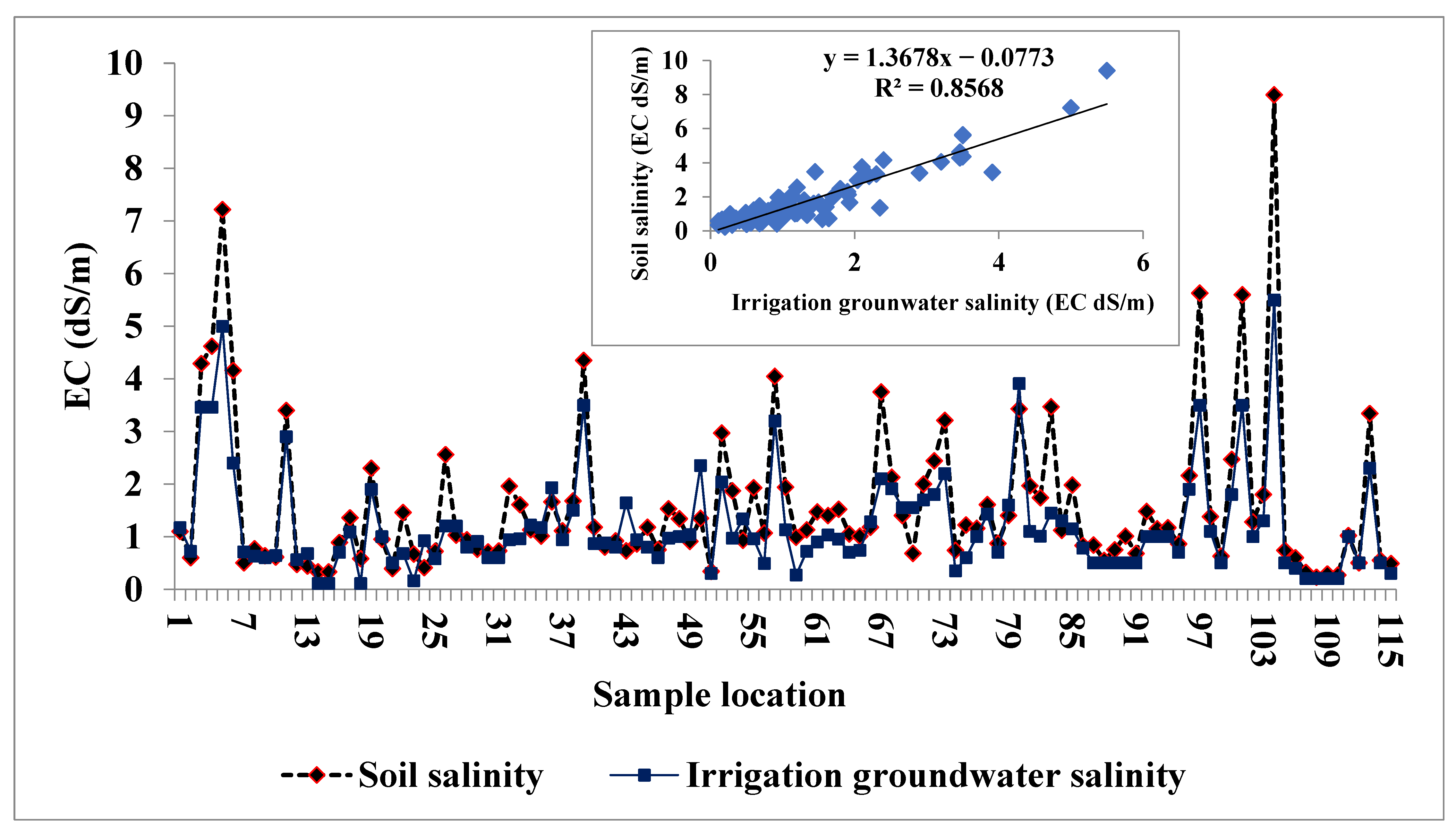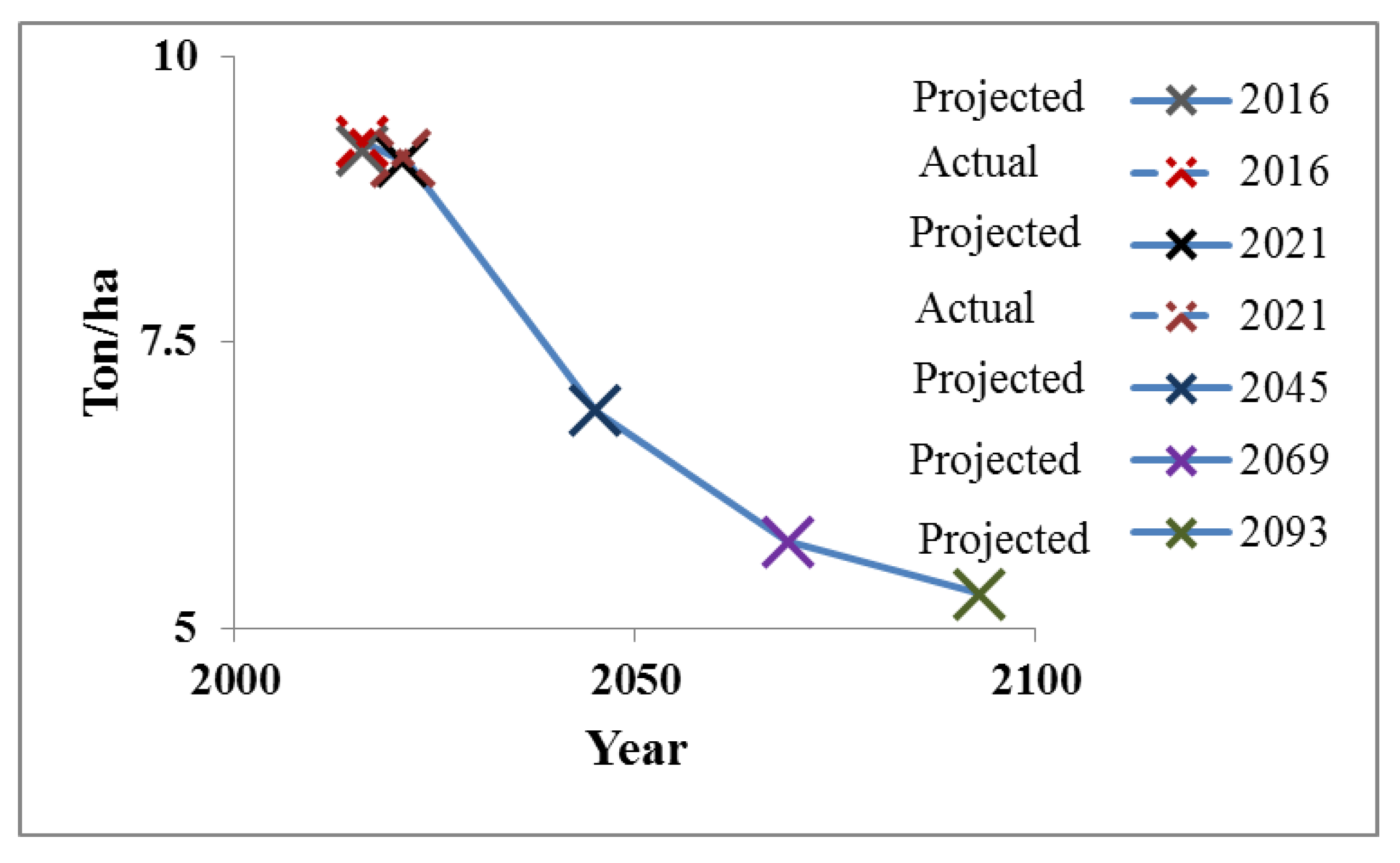Effect of Climate Change on the Quality of Soil, Groundwater, and Pomegranate Fruit Production in Al-Baha Region, Saudi Arabia: A Modeling Study Using SALTMED
Abstract
1. Introduction
2. Materials and Methods
2.1. Study Area
2.2. Soil and Groundwater Sampling and Analysis
Groundwater Analysis
2.3. Soil Analysis
2.4. The Description SALTMED Model
2.5. Model Data Requirements
- Soil properties included hydraulic conductivity, soil horizon depth, saturated soil water content, saturated salt diffusion coefficient, longitudinal and transversal dispersion coefficient, initial soil moisture and salinity profiles, soil moisture versus hydraulic conductivity, and tabulated data of soil moisture versus soil water potential. Laboratory measurements were used to obtain the parameters of the soil water retention curves, whereas initial soil water content, shallow groundwater depth and salinity, and soil salinity were based on measurements either made in the laboratory or in the field.
- Meteorological data were provided by the meteorological station of Saudi Arabia, and TU TIEMPO.NET (online at: https://en.tutiempo.net/climate/01-2021/ws-410550.html, accessed on 1 May 2022). The meteorological data consisted of the daily maximum and minimum temperatures along with the relative humidity, wind speed, precipitation data, and the radiation.
2.6. SALTMED Calibration and Validation
2.7. Statistical Analyses
3. Results and Discussion
3.1. Sarat Al-Baha Climatic History
3.2. Change Detection of Al-Baha Groundwater Quality
3.3. Groundwater Salinity Impact on Soil Salinity
3.4. SALTMED Model Calibration and Validation
3.5. Projection of Soil Salinity in the Al-Baha Region
3.6. Projection of Pomegranate Fruit Yields in the Al-Baha Region
4. Conclusions
Author Contributions
Funding
Institutional Review Board Statement
Informed Consent Statement
Data Availability Statement
Conflicts of Interest
Appendix A
| Location | Calibration Process | Location | Calibration Process | ||
|---|---|---|---|---|---|
| Observed (EC dS m−1) | Simulated (EC dS m−1) | Observed (EC dS m−1) | Simulated (EC dS m−1) | ||
| 1 | 1.10 | 1.13 | 33 | 1.61 | 1.50 |
| 2 | 0.60 | 0.80 | 34 | 1.13 | 0.90 |
| 3 | 4.29 | 4.10 | 35 | 1.01 | 1.00 |
| 4 | 4.62 | 4.30 | 36 | 1.66 | 1.40 |
| 5 | 7.22 | 6.99 | 37 | 1.11 | 1.00 |
| 6 | 4.16 | 4.02 | 38 | 1.68 | 1.30 |
| 7 | 0.50 | 0.60 | 39 | 4.35 | 4.10 |
| 8 | 0.77 | 0.90 | 40 | 1.18 | 1.01 |
| 9 | 0.64 | 0.80 | 41 | 0.80 | 0.70 |
| 10 | 0.61 | 0.70 | 42 | 0.92 | 0.80 |
| 11 | 3.40 | 3.20 | 43 | 0.73 | 0.70 |
| 12 | 0.47 | 0.70 | 44 | 0.86 | 0.80 |
| 13 | 0.44 | 0.50 | 45 | 1.18 | 1.10 |
| 14 | 0.33 | 0.50 | 46 | 0.75 | 0.80 |
| 15 | 0.33 | 0.50 | 47 | 1.53 | 1.50 |
| 16 | 0.89 | 1.00 | 48 | 1.34 | 1.20 |
| 17 | 1.36 | 1.20 | 49 | 0.91 | 0.80 |
| 18 | 0.58 | 0.80 | 50 | 1.35 | 1.50 |
| 19 | 2.30 | 2.20 | RMSE | 0.11 | |
| 20 | 0.95 | 1.10 | CRM | 0.02 | |
| 21 | 0.39 | 0.50 | |||
| 22 | 1.46 | 1.80 | Notes: RMSE = root mean square error. CRM = coefficient of residual mass | ||
| 23 | 0.67 | 0.80 | |||
| 24 | 0.41 | 0.50 | |||
| 25 | 0.72 | 0.80 | |||
| 26 | 2.56 | 2.40 | |||
| 27 | 1.03 | 0.90 | |||
| 28 | 0.94 | 0.80 | |||
| 29 | 0.76 | 0.80 | |||
| 30 | 0.71 | 0.60 | |||
| 31 | 0.73 | 0.80 | |||
| 32 | 1.96 | 1.70 | |||
| Location | Validation Process | Location | Validation Process | ||
|---|---|---|---|---|---|
| Observed (EC dS m−1) | Simulated (EC dS m−1) | Observed (EC dS m−1) | Simulated (EC dS m−1) | ||
| 51 | 0.34 | 0.60 | 84 | 1.12 | 1.10 |
| 52 | 2.97 | 2.80 | 85 | 1.98 | 1.89 |
| 53 | 1.87 | 1.80 | 86 | 0.83 | 0.80 |
| 54 | 0.93 | 1.00 | 87 | 0.84 | 0.79 |
| 55 | 1.93 | 1.01 | 88 | 0.55 | 0.50 |
| 56 | 1.07 | 0.90 | 89 | 0.75 | 0.70 |
| 57 | 4.05 | 3.91 | 90 | 1.01 | 1.00 |
| 58 | 1.94 | 2.00 | 91 | 0.68 | 0.60 |
| 59 | 0.99 | 1.00 | 92 | 1.48 | 1.29 |
| 60 | 1.13 | 0.99 | 93 | 1.15 | 1.10 |
| 61 | 1.47 | 1.35 | 94 | 1.17 | 1.12 |
| 62 | 1.40 | 1.30 | 95 | 0.86 | 1.40 |
| 63 | 1.52 | 1.40 | 96 | 2.16 | 2.10 |
| 64 | 1.05 | 0.90 | 97 | 5.63 | 5.31 |
| 65 | 1.01 | 0.90 | 98 | 1.38 | 1.10 |
| 66 | 1.18 | 1.10 | 99 | 0.63 | 0.20 |
| 67 | 3.75 | 3.53 | 100 | 2.47 | 2.30 |
| 68 | 2.13 | 2.20 | 101 | 5.60 | 5.41 |
| 69 | 1.40 | 1.50 | 102 | 1.28 | 0.90 |
| 70 | 0.68 | 0.80 | 103 | 1.80 | 1.50 |
| 71 | 2.00 | 1.90 | 104 | 9.40 | 8.90 |
| 72 | 2.44 | 2.30 | 105 | 0.74 | 0.55 |
| 73 | 3.21 | 3.10 | 106 | 0.60 | 0.50 |
| 74 | 0.74 | 0.50 | 107 | 0.32 | 0.40 |
| 75 | 1.22 | 1.10 | 108 | 0.23 | 0.70 |
| 76 | 1.16 | 1.10 | 109 | 0.29 | 0.40 |
| 77 | 1.61 | 1.50 | 110 | 0.27 | 0.70 |
| 78 | 0.87 | 0.90 | 111 | 1.02 | 0.90 |
| 79 | 1.40 | 1.30 | 112 | 0.50 | 0.60 |
| 80 | 3.43 | 3.30 | 113 | 3.34 | 3.10 |
| 81 | 1.97 | 1.87 | 114 | 0.55 | 0.60 |
| 82 | 1.74 | 1.60 | 115 | 0.49 | 0.80 |
| 83 | 3.47 | 3.40 | RMSE | 0.17 | |
| CRM | 0.05 | ||||
References
- Treidel, H.; Martin-Bordes, J.J.; Gurdak, J.J. (Eds.) Climate Change Effects on Groundwater Resources: A Global Synthesis of Findings and Recommendations. In International Association of Hydrogeologists (IAH)—International Contributions to Hydrogeology; Taylor & Francis publishing: Abingdon, UK, 2012; p. 414. [Google Scholar]
- Obianyo, J.L. Effect of salinity on evaporation and water cycle. Emerg. Sci. J. 2019, 4, 255–262. [Google Scholar] [CrossRef]
- Wu, W.Y.; Lo, M.H.; Wada, Y.; Famiglietti, J.S.; Yeh, P.F.; Ducharane, A.; Yang, Z.L. Divergent effects of climate change on future groundwater availability in key mid-latitude aquifers. Nat. Commun. 2020, 11, 3710. [Google Scholar] [CrossRef] [PubMed]
- Aly, A.A.; Al-Omran, A.M.; Sallam, A.S.; Al-Wabel, M.I.; Al-Shayaa, M.S. Vegetation Cover Change Detection and Assessment in Arid Environment Using Multi-temporal Remote Sensing images and Ecosystem Management Approach. Solid Earth 2016, 7, 713–725. [Google Scholar] [CrossRef]
- Al-Omran, A.M.; Aly, A.A.; Al-Wabel, M.I.; Sallam, A.S.; Al-Shayaa, M.S. Hydrochemical Characterization of Groundwater under Agricultural Land in Arid Environment: A Case Study of Al-Kharj, Saudi Arabia. Arab. J. Geosci. 2016, 9, 68–85. [Google Scholar] [CrossRef]
- Alghamdi, A.G.; Aly, A.A.; Ibrahim, H.M. Assessment of contamination by potentially toxic trace elements of groundwater and soil surrounding municipal soil waste landfill: A case study from Saudi Arabia. Arab. J. Geosci. 2021, 14, 350–362. [Google Scholar] [CrossRef]
- Taylor, R.; Tindimugaya, C. The Impact of Climate Change and Rapid Development on Weathered Crystalline Rock Aquifer Systems in the Humid Tropics of sub-Saharan Africa: Evidence from South-western Uganda. In Climate Change Effects on Groundwater Resources: A Global Synthesis of Findings and Recommendations. International Association of Hydrogeologists (IAH)—International Contributions to Hydrogeology; Treidel, H., Martin-Bordes, J.J., Gurdak, J.J., Eds.; Taylor & Francis Publishing: Abingdon, UK, 2012; pp. 17–32. [Google Scholar]
- National Oceanic and Atmospheric Administration (NOAA). National Centers for Environmental Information. Numerical Weather Prediction. 2017. Available online: https://www.ncdc.noaa.gov/data-access/model-data/model-datasets/numerical-weather-prediction (accessed on 20 June 2021).
- Xiaolong, G.; Boufadel, M.C. The influence of evaporation and rainfall on supratidal groundwater dynamics and salinity structure in a sandy beach. Water Resour. Res. 2017, 53, 6218–6238. [Google Scholar]
- Ludwig, F.; Moench, M. The Impacts of Climate Change on Water. In Climate Change Adaptation in the Water Sector; Ludwig, F., Kabat, P., Schaik, H.V., van der Valk, M., Eds.; Earthscan Publishing: London, UK, 2009; pp. 35–50. [Google Scholar]
- Ober, J.; Karwot, J.; Rusakov, S. Tap Water Quality and Habits of Its Use: A Comparative Analysis in Poland and Ukraine. Energies 2022, 15, 981. [Google Scholar] [CrossRef]
- Ji, Y.; Wu, J.; Wang, Y.; Elumalai, V.; Subramani, T. Seasonal Variation of Drinking Water Quality and Human Health Risk Assessment in Hancheng City of Guanzhong Plain, China. Expo. Health 2020, 12, 469–485. [Google Scholar] [CrossRef]
- Zhang, H.; Xu, L.; Huang, T.; Yan, M.; Liu, K.; Miao, Y.; He, H.; Li, S.; Sekar, R. Combined effects of seasonality and stagnation on tap water quality: Changes in chemical parameters, metabolic activity and co-existence in bacterial community. J. Hazard. Mater. 2021, 403, 124018. [Google Scholar] [CrossRef] [PubMed]
- Aly, A.A. Soil and groundwater salinization in Siwa Oasis and management opportunities: Twenty year change detection and assessment. Arid Land Res. Manag. 2020, 34, 117–135. [Google Scholar] [CrossRef]
- Al-Barakah, F.N.; Aly, A.A.; Abaakhel, E.H.S.; Al-Rizkid, A.M.; Alghamdi, A.G.; Al-Sewailem, M.S. Comparison and Hydrochemical Characterization of Groundwater Resources in the Arabian Peninsula: A Case Study of Al-Baha and Al-Qassim in Saudi Arabia. Water Resour. 2020, 47, 877–891. [Google Scholar] [CrossRef]
- Aly, A.A.; Gaber, H.M.; Kishk, F.M.; Al-Omran, A.M. Long-term detection and hydrochemistry of groundwater resources in Siwa Oasis. Egypt. J. Saudi Soc. Agric. Sci. 2016, 15, 67–74. [Google Scholar] [CrossRef]
- Jyrkama, I.M.; Sykes, J.F. The impact of climate change on spatially varying groundwater recharge in the Grand River watershed. J. Hydrol. 2007, 338, 237–250. [Google Scholar] [CrossRef]
- Lee, L.J.E.; Lawrence, D.S.L.; Price, M. Analysis of water level response to rainfall and implications for recharge pathways in the Chalk aquifer, SE England. J. Hydrol. 2006, 330, 604–620. [Google Scholar] [CrossRef]
- Wada, Y.; van Beek, L.P.H.; Bierkens, M.F.P. Nonsustainable groundwater sustaining irrigation: A global assessment. Water Resour. Res. 2012, 48, W00L06. [Google Scholar] [CrossRef]
- Alghamdi, A.G.; Aly, A.A.; Majrashi, M.A.; Ibrahim, H.M. Impact of climate change on hydrochemical properties and quality of groundwater for domestic and irrigation purposes in arid environment: A case study of Al-Baha region, Saudi Arabia. Environ. Earth Sci. 2022. under review. [Google Scholar] [CrossRef]
- General Authority for Statistics (GAS). Agricultural Production Survey; GAS: Riyadh, Saudi Arabia, 2019; Volume 1, pp. 1–89. (In Arabic)
- Qingyun, Z.; Shaozhong, K.; Lu, Z.; Fusheng, L. Comparison of APRI and Hydrus-2D models to simulate soil water dynamics in a vineyard under alternate partial root zone drip irrigation. Plant Soil. 2007, 291, 211–223. [Google Scholar]
- Selim, T. Influence of geometric design of alternate partial root-zone subsurface drip irrigation (APRSDI) with brackish water on soil moisture and salinity distribution. Agric. Water Manag. 2012, 103, 182–190. [Google Scholar] [CrossRef]
- Ragab, R. SALTMED Model 2019 Is an Integrated Management Tool for Management of Water, Crop, Soil and N-Fertilizers. 2019. Available online: https://www.ceh.ac.uk/services/saltmed#download (accessed on 25 June 2021).
- Ragab, R. A holistic generic integrated approach for irrigation, crop and field management: The SALTMED model. Environ. Model. Softw. 2002, 17, 345–361. [Google Scholar] [CrossRef]
- Hirich, A.; Fatnassi, H.; Ragab, R.; Choukr-Allah, R. Prediction of Climate Change Impact on Corn Grown in the South of Morocco Using the Saltmed Model. Irrig. Drain. 2016, 65, 9–18. [Google Scholar] [CrossRef]
- Ragab, R. Advances in Integrated Management of Fresh and Saline Water for Sustainable Crop Production: Modelling and Practical Solutions. Int. J. Agric. Water Manag. (Spec. Issue) 2005, 78, 1–164. [Google Scholar]
- Ragab, R.; Malash, N.; Gawad, G.A.; Arslan, A.; Ghaibeh, A. A holistic generic integrated approach for irrigation, crop and field management: 1. The SALTMED model and its calibration using field data from Egypt and Syria. Agric. Water Manag. 2005, 78, 67–88. [Google Scholar] [CrossRef]
- Ragab, R.; Malash, N.; Gawad, G.A.; Arslan, A.; Ghaibeh, A. A holistic generic integrated approach for irrigation, crop and field management: 2. The SALTMED model validation using field data of five growing seasons from Egypt and Syria. Agric. Water Manag. 2005, 78, 89–107. [Google Scholar] [CrossRef]
- Golabi, M.; Naseri, A.A.; Kashkuli, H.A. Evaluation of SALTMED model performance in irrigation and drainage of sugarcane farms in Khuzestan province of Iran. J. Food Agric. Environ. 2009, 7, 874–880. [Google Scholar]
- Montenegro, S.G.; Montenegro, A.; Ragab, R. Improving Agricultural Water Management in the Semi-Arid Region of Brazil: Experimental and Modelling Study. In Irrigation Science; Springer: Berlin/Heidelberg, Germany, 2010; Volume 28, pp. 301–316. [Google Scholar]
- Ragab, R. SALTMED Model as an Integrated Management Tool for Water, Crop, Soil and Fertilizers; Instituto Nacional de Ciencia e Technologia em Salinidade: Fortaleza, CE, Brasil, 2010. [Google Scholar]
- Aly, A.A. Impact of irrigation management on shallow groundwater fluctuation and soil salinity: The Saltmed model. Egyptian J. Soil Sci. 2014, 54, 355–371. Available online: http://journal4.js.iknito.com/article_183_47.html (accessed on 1 June 2021).
- Aly, A.A.; Al-Omran, A.M.; Khasha, A.A. Water management for cucumber: Greenhouse experiment in Saudi Arabia and modeling study using SALTMED model. J. Soil Water Conserv. 2015, 70, 1–11. [Google Scholar] [CrossRef]
- Mohammed, A.; Georg, T.; Christoph, S.; Randolf, R. Challenges for an Integrated Groundwater Management in the Kingdom of Saudi Arabia. Int. J. Water Resour. Arid. Environ. 2011, 1, 65–70. [Google Scholar]
- GAMEPKSA (General Authority of Meteorology and Environmental Protection in the Kingdom of Saudi Arabia), National Center for Meteorology. Available online: https://ncm.gov.sa/ar/Pages/default.aspx# (accessed on 15 July 2022).
- APHA. Standard Methods for the Examination of Water and Wastewater, 20th ed.; American Public Health Association: Washington, DC, USA, 1998. [Google Scholar]
- Matiti, S.K. Handbook of Methods in Environmental Studies: Water and Wastewater Analysis; ABD Publishers: Jaipur, India, 2004. [Google Scholar]
- Tabatabai, M.A. Methods of Soil Analysis, Part 3: Chemical Methods; Sparks, D.L., Helmke, P.A., Loeppert, R.H., Eds.; SSSA Book Series 5; ASA: Madison, WI, USA; SSSA: Madison, WI, USA, 1996. [Google Scholar]
- Sparks, D.L. Methods of Soil Analysis; Soil Society of American, ASA: Madison, WI, USA, 1996. [Google Scholar]
- Hillel, D. Soil and Water Physical Principles and Processes; Academic Press: New York, NY, USA, 1971. [Google Scholar]
- Richards, L.A. Porous plate apparatus for measuring moisture relation and transmutation. Soil Sci. 1948, 66, 105–110. [Google Scholar] [CrossRef]
- Hirich, A.; Choukr-Allah, R.; Ragab, R.; Jacobsen, S.E.; El Youssfi, L.; El Omari, H. The SALTMED model calibration and validation using field data from Morocco. J. Mater. Environ. Sci. 2012, 3, 342–359. [Google Scholar]
- Allen, R.G.; Pereira, L.S.; Raes, D.; Smith, M. Crop evapotranpiration guidelines for computing crop water requirements Irrigation and Drainage paper 56; Food and Agriculture Organization: Rome, Italy, 1998. [Google Scholar]
- Loague, K.; Green, R.E. Statistical and graphical methods for evaluating solute transport models: Overview and application. J. Contam. Hydrol. 1991, 7, 51–71. [Google Scholar] [CrossRef]
- Ramakrishnaiah, C.R.; Sadashivaiah, C.; Ranganna, G. Assessment of Water Quality Index for the Groundwater in Tumkur Taluk, Karnataka State, India. E-J. Chem. 2009, 6, 523–530. [Google Scholar] [CrossRef]
- Lauchli, A.; Epstein, E. Plant responses to saline and sodic conditions. In Agricultural Salinity Assessment and Management; Tanji, K.K., Ed.; ASCE Manuals and Reports on Engineering Practice; ASCE: New York, NY, USA, 1990; Volume 71, pp. 113–137. [Google Scholar]
- Appelo, C.A.J.; Postma, D. Geochemistry, Groundwater and Pollution; CRC Press: Balkema, Rotterdam, 1996. [Google Scholar]
- Jalali, M. Chemical characteristics of groundwater in parts of mountainous region, Alvand, Hamadan, Iran. Environ. Earth Sci. 2006, 51, 433–446. [Google Scholar] [CrossRef]
- Flowers, T.; Ragab, R.; Malash, N.; Gawad, G.A.; Cuartero, J.; Arslan, A. Sustainable strategies for irrigation in salt-prone Mediterranean: SALTMED. Agric. Water Manag. 2005, 78, 3–14. [Google Scholar] [CrossRef]
- Silva, L.L.; Ragab, R.; Duarte, I.; Lourenco, E.M.; Simões, N.; Chaves, M.M. Calibration and validation of SALTMED model under dry and wet year conditions using chickpea field data from Southern Portugal. Irrig. Sci. 2012, 31, 651–659. [Google Scholar] [CrossRef]







| Sampling | pH | ECW | Cations (meq L−1) | Anions (meq L−1) | NO3− (mg L−1) | ||||||
|---|---|---|---|---|---|---|---|---|---|---|---|
| Date | (dS m−1) | Ca++ | Mg++ | Na+ | K+ | CO3− | HCO3− | Cl− | SO4− | ||
| August 2016 * | 8.01 | 0.8 | 1.8 | 4.3 | 1.9 | 0.2 | 0.0 | 2.9 | 4.7 | 0.7 | 5.7 |
| August 2020 | 7.70 | 1.1 | 3.1 | 6.2 | 2.1 | 0.3 | 0.0 | 1.0 | 8.5 | 1.7 | 4.1 |
| Parameter | Unit | Surface Layer (0–30 cm) |
|---|---|---|
| EC | dS m−1 | 2.22 |
| pH | - | 7.69 |
| CaCO3 | % | 1.11 |
| Soil texture | - | Loamy sand |
| Sand | % | 78.45 |
| Silt | % | 19.96 |
| Clay | % | 1.59 |
| Bulk density | g cm−3 | 1.31 |
| Saturated hydraulic conductivity | mm d−1 | 1614 |
| Salinity | dS m−1 | 2.07 |
| Water content at saturation (porosity) | m3m−3 | 0.420 |
| Water content at field capacity | m3m−3 | 0.196 |
| Water content at wilting point | m3m−3 | 0.043 |
| Residual water content | m3m−3 | 0.035 |
| Bubbling pressure | cm | 14.2 |
| Root width factor | - | 1 |
| Max depth for evaporation | mm | 140 |
| Lambda pore size distribution index | - | 1.25 |
| Longitudinal dispersivity | cm | 1.5 |
| Transverse dispersivty | cm | 0.1 |
| Calibration Process | Validation Process | |
|---|---|---|
| RMSE | 0.11 | 0.17 |
| CRM | 0.02 | 0.05 |
Publisher’s Note: MDPI stays neutral with regard to jurisdictional claims in published maps and institutional affiliations. |
© 2022 by the authors. Licensee MDPI, Basel, Switzerland. This article is an open access article distributed under the terms and conditions of the Creative Commons Attribution (CC BY) license (https://creativecommons.org/licenses/by/4.0/).
Share and Cite
Alghamdi, A.G.; Aly, A.A.; Ibrahim, H.M. Effect of Climate Change on the Quality of Soil, Groundwater, and Pomegranate Fruit Production in Al-Baha Region, Saudi Arabia: A Modeling Study Using SALTMED. Sustainability 2022, 14, 13275. https://doi.org/10.3390/su142013275
Alghamdi AG, Aly AA, Ibrahim HM. Effect of Climate Change on the Quality of Soil, Groundwater, and Pomegranate Fruit Production in Al-Baha Region, Saudi Arabia: A Modeling Study Using SALTMED. Sustainability. 2022; 14(20):13275. https://doi.org/10.3390/su142013275
Chicago/Turabian StyleAlghamdi, Abdulaziz G., Anwar A. Aly, and Hesham M. Ibrahim. 2022. "Effect of Climate Change on the Quality of Soil, Groundwater, and Pomegranate Fruit Production in Al-Baha Region, Saudi Arabia: A Modeling Study Using SALTMED" Sustainability 14, no. 20: 13275. https://doi.org/10.3390/su142013275
APA StyleAlghamdi, A. G., Aly, A. A., & Ibrahim, H. M. (2022). Effect of Climate Change on the Quality of Soil, Groundwater, and Pomegranate Fruit Production in Al-Baha Region, Saudi Arabia: A Modeling Study Using SALTMED. Sustainability, 14(20), 13275. https://doi.org/10.3390/su142013275






